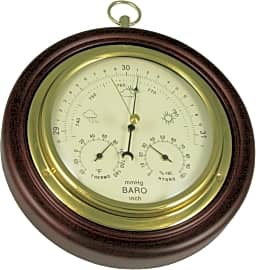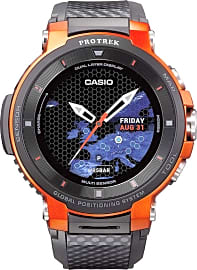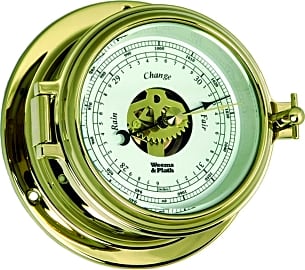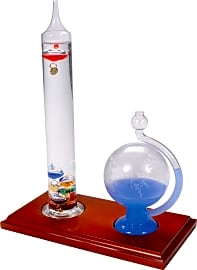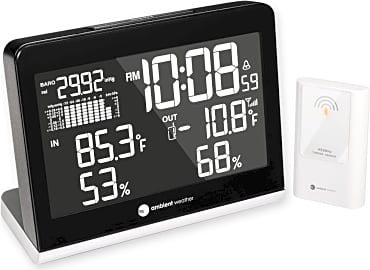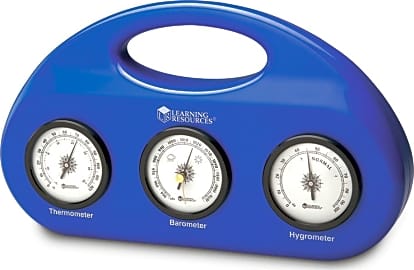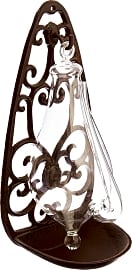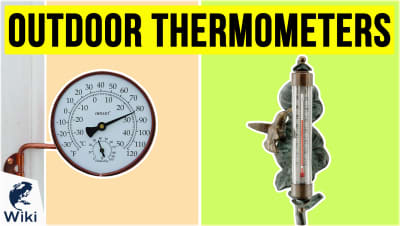The 10 Best Barometers

This wiki has been updated 36 times since it was first published in January of 2016. While there's no shortage of ways to find an accurate forecast these days, nothing can rival the pleasure of watching a barometer to see if a storm's coming in. Our selections can help you stay out of the rain, while also giving your home a touch of elegance that the Weather Channel will never be able to match. We've ranked them here by their accuracy, style, and additional features. When users buy our independently chosen editorial picks, we may earn commissions to help fund the Wiki.
Editor's Notes
March 02, 2020:
With a relatively broad category like barometers, we want to make sure there's something for everyone, from the science teacher trying to educates kids about the connection between air pressure and weather patterns to the sailor trying to avoid dangerous seas. That's why we included models like the durable and kid-friendly Learning Resources Center and the boat-dash-mountable Weems And Plath Endurance II.
One of the important dividing lines here is drawn on the feature of accuracy. Seeing the water level go down in a old-fashioned glass pressure gauge is great if you just need an idea that it's liable to get sunny or rainy on a given morning, but more precision requires instruments with actual markings like the Ambient Traditional. And if your adventures take you somewhere you'll need to add GPS features and more to your arsenal of tools, the Casio Pro Trek Outdoor is there to answer that call. It's one of several watches with a barometer/altimeter function, and given its extra features, may be a smart choice for taking long hikes and wanting to both track your location and ensure you don't get caught in adverse conditions.
What Exactly Is Barometric Pressure?
Now, if you were to take all the atmosphere that fit inside the column and place it on a scale, it would have a certain weight.
If you have any old injuries that plague you whenever the weather takes a turn, then you have a very direct experience with barometric pressure. The reason for this sensation is that the physical pressure that the atmosphere exerts on your body changes as the weather changes, and that can be the equivalent of a five or 10 pound weight being placed on or taken off of a given area of your body.
To make more sense of this, we should talk about what it is that barometric pressure represents, which is the physical force that the atmosphere exerts on the earth. The atmosphere itself is a material substance, after all, and it has a measurable mass and weight. A variety of forces can act on this material, however, including everything from gravitational forces to solar flares, and alterations to the density of this material and the pressure that it exerts have direct correlations to the planet’s weather activity.
Imagine, if you will a column rising out of the earth at sea level, and extending all the way to the absolute top of the atmosphere. That’s a pretty long column. Now, if you were to take all the atmosphere that fit inside the column and place it on a scale, it would have a certain weight. Weigh this on a cool, rainy day, and it’s liable to have a different weight than it would have on a warm, sunny day. That’s because there’s a correlation between the density of the atmosphere and weather activity, and if you can more densely pack that imaginary column with everything that constitutes our atmosphere, it will be heavier.
So, atmospheric density correlates to atmospheric pressure, but how do we measure it, and how do you then interpret those measurements? There are a few ways that we measure atmospheric pressure, but the mercury barometer is one that set the standard for predicting the behavior of certain weather patterns, such as whether a given cloud formation is liable to split open and soak the ground beneath it or move on to another area.
Essentially, you have a glass tube sitting in a reservoir of mercury, and the weight of the mercury creates a vacuum in the tube. Atmospheric pressure on the mercury causes it to climb inside the tube, and scientists would measure the height of the mercury in inches to determine how much pressure the atmosphere was exerting on the reservoir. The range in which our atmosphere regularly moves exists between the 26.5 and 31.5 inch markings, yet the average point of barometric pressure — the amount of pressure we equate to the measurement of one bar, or one atmosphere — exists when the mercury measures 29.92 inches.
When the mercury drops, corresponding to a drop in pressure, you can expect cooler temperatures and a greater risk of precipitation and other weather that most people prefer to avoid. Sudden, steep drops can indicate more severe weather patterns, as well. On the other hand, rising pressure usually indicates clear skies, calm winds, and more comfortable temperatures.
What Does Barometric Pressure Matter To Me?
Keeping an eye on the barometric pressure around your home or office can be crucial, especially if you live in an area that can sometimes encounter extreme weather or flooding. And whether or not you believe that climate change is a result of human activity (it totally is), it’s hard to deny that the climate is, in fact, changing, and that one of those changes is in the weather patterns common to many areas.
As climate change rages on, arid lands may get more rain than ever, though likely in the form of sudden downpours and flash floods which do little to alleviate drought.
As climate change rages on, arid lands may get more rain than ever, though likely in the form of sudden downpours and flash floods which do little to alleviate drought. Temperate regions may become more like deserts, and fertile farmland will likely migrate farther away from the equator and more towards the planet’s poles.
With all of these changes in weather patterns, it can be hard to know what kind of weather is headed your way. If you think you can rely on weather reporting to keep you informed, think again. Even those percentage stats, like 50 percent chance of rain, for example, only mean that 50 percent of a given area will experience rain, not that there’s a 50/50 chance of it happening at all. In other words, any instruments you can use to reliably predict the weather in your immediate vicinity are vital, and as the years wear on they only stand to become moreso.
As we mentioned above, there’s also a direct relationship between barometric pressure and the pain you might feel in an old injury or current ailment, whether we’re talking about a bad bone break from years ago or a current battle with something like arthritis. If you have a barometer that you can reference one a regular basis, you can take prescribed medicines or over-the-counter pain meds in advance of the worst of it, potentially making your experience much less unpleasant.
A Brief History Of The Barometer
The first functional, reliable barometers were created in Italy in the middle of the 17th century. Evangelista Torricelli is often given credit for creating the first one in 1643, but a mathematician named Gasparo Berti was also working on a very similar instrument some years earlier. Several noteworthy minds attempted to recreate Torricelli’s invention after hearing about it, including Blaise Pascal, whoe public tests of the instrument drew the attention of the masses.
In addition to realizing a correlation with the weather, barometers became integral to the safety of aircraft at the advent of human flight. As you get higher above sea level, there’s less atmosphere to exert pressure on a given barometer, so you could take a barometric reading at altitude and reverse engineer it to tell you how high above sea level you were flying.
Many of today’s barometers rely on peizoelectric sensors that translate pressure exerted on a crystal into specific electrical currents that are interpreted to correspond to the recognizable measurements first developed in the mercury-based Torricelli barometer. These units are smaller, safer, and more reliable than mercury models.



